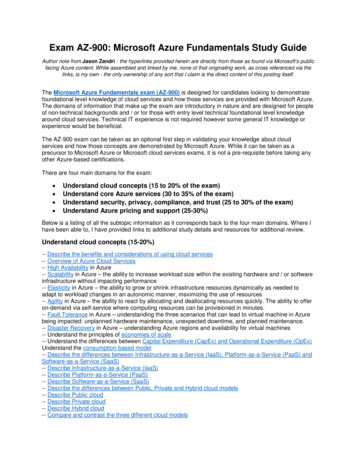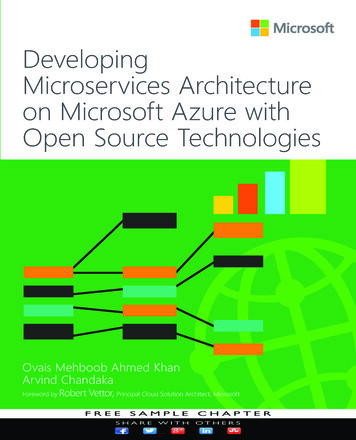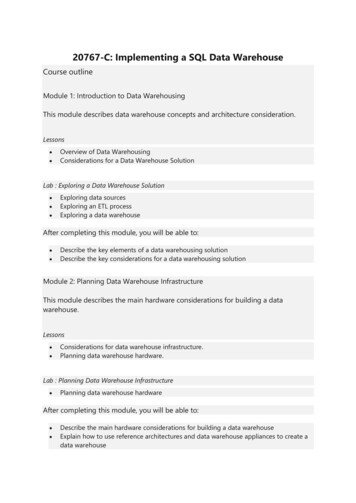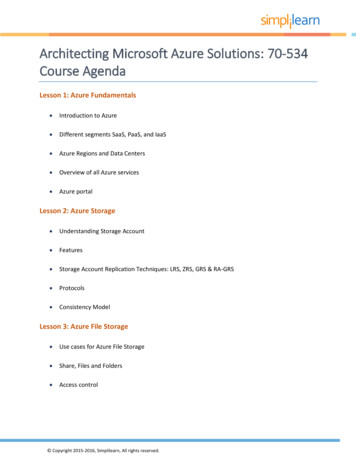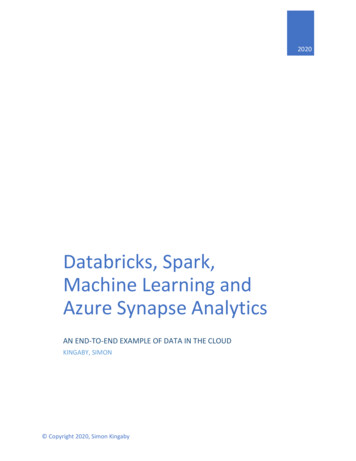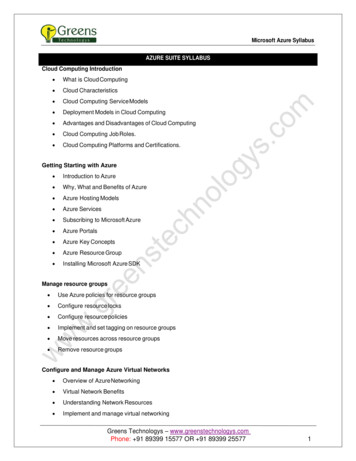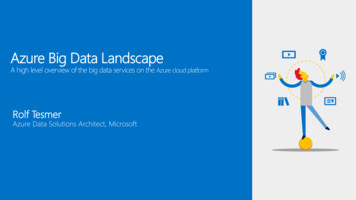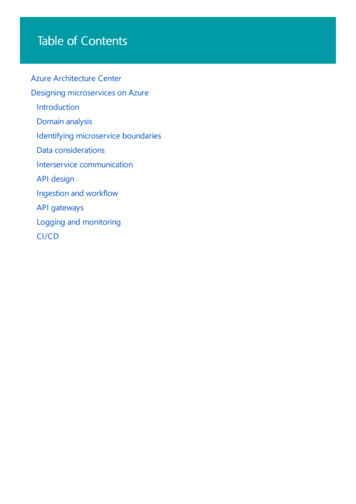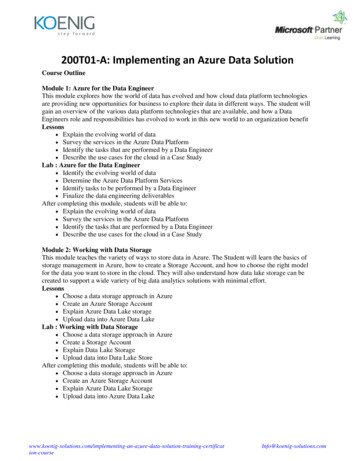
Transcription
200T01-A: Implementing an Azure Data SolutionCourse OutlineModule 1: Azure for the Data EngineerThis module explores how the world of data has evolved and how cloud data platform technologiesare providing new opportunities for business to explore their data in different ways. The student willgain an overview of the various data platform technologies that are available, and how a DataEngineers role and responsibilities has evolved to work in this new world to an organization benefitLessons Explain the evolving world of data Survey the services in the Azure Data Platform Identify the tasks that are performed by a Data Engineer Describe the use cases for the cloud in a Case StudyLab : Azure for the Data Engineer Identify the evolving world of data Determine the Azure Data Platform Services Identify tasks to be performed by a Data Engineer Finalize the data engineering deliverablesAfter completing this module, students will be able to: Explain the evolving world of data Survey the services in the Azure Data Platform Identify the tasks that are performed by a Data Engineer Describe the use cases for the cloud in a Case StudyModule 2: Working with Data StorageThis module teaches the variety of ways to store data in Azure. The Student will learn the basics ofstorage management in Azure, how to create a Storage Account, and how to choose the right modelfor the data you want to store in the cloud. They will also understand how data lake storage can becreated to support a wide variety of big data analytics solutions with minimal effort.Lessons Choose a data storage approach in Azure Create an Azure Storage Account Explain Azure Data Lake storage Upload data into Azure Data LakeLab : Working with Data Storage Choose a data storage approach in Azure Create a Storage Account Explain Data Lake Storage Upload data into Data Lake StoreAfter completing this module, students will be able to: Choose a data storage approach in Azure Create an Azure Storage Account Explain Azure Data Lake Storage Upload data into Azure Data oenig-solutions.com
Module 3: Enabling Team Based Data Science with Azure DatabricksThis module introduces students to Azure Databricks and how a Data Engineer works with it toenable an organization to perform Team Data Science projects. They will learn the fundamentals ofAzure Databricks and Apache Spark notebooks; how to provision the service and workspaces andlearn how to perform data preparation task that can contribute to the data science project.Lessons Explain Azure Databricks Work with Azure Databricks Read data with Azure Databricks Perform transformations with Azure DatabricksLab : Enabling Team Based Data Science with Azure Databricks Explain Azure Databricks Work with Azure Databricks Read data with Azure Databricks Perform transformations with Azure DatabricksAfter completing this module, students will be able to: Explain Azure Databricks Work with Azure Databricks Read data with Azure Databricks Perform transformations with Azure DatabricksModule 4: Building Globally Distributed Databases with Cosmos DBIn this module, students will learn how to work with NoSQL data using Azure Cosmos DB. Theywill learn how to provision the service, and how they can load and interrogate data in the serviceusing Visual Studio Code extensions, and the Azure Cosmos DB .NET Core SDK. They will alsolearn how to configure the availability options so that users are able to access the data from anywherein the world.Lessons Create an Azure Cosmos DB database built to scale Insert and query data in your Azure Cosmos DB database Build a .NET Core app for Cosmos DB in Visual Studio Code Distribute your data globally with Azure Cosmos DBLab : Building Globally Distributed Databases with Cosmos DB Create an Azure Cosmos DB Insert and query data in Azure Cosmos DB Build a .Net Core App for Azure Cosmos DB using VS Code Distribute data globally with Azure Cosmos DBAfter completing this module, students will be able to: Create an Azure Cosmos DB database built to scale Insert and query data in your Azure Cosmos DB database Build a .NET Core app for Azure Cosmos DB in Visual Studio Code Distribute your data globally with Azure Cosmos nig-solutions.com
Module 5: Working with Relational Data Stores in the CloudIn this module, students will explore the Azure relational data platform options including SQLDatabase and SQL Data Warehouse. The student will be able explain why they would choose oneservice over another, and how to provision, connect and manage each of the services.Lessons Use Azure SQL Database Describe Azure SQL Data Warehouse Creating and Querying an Azure SQL Data Warehouse Use PolyBase to Load Data into Azure SQL Data WarehouseLab : Working with Relational Data Stores in the Cloud Use Azure SQL Database Describe Azure SQL Data Warehouse Creating and Querying an Azure SQL Data Warehouse Use PolyBase to Load Data into Azure SQL Data WarehouseAfter completing this module, students will be able to: Use Azure SQL Database Describe Azure Data Warehouse Creating and Querying an Azure SQL Data Warehouse Using PolyBase to Load Data into Azure SQL Data WarehouseModule 6: Performing Real-Time Analytics with Stream AnalyticsIn this module, students will learn the concepts of event processing and streaming data and how thisapplies to Events Hubs and Azure Stream Analytics. The students will then set up a stream analyticsjob to stream data and learn how to query the incoming data to perform analysis of the data. Finally,you will learn how to manage and monitor running jobs.Lessons Explain data streams and event processing Data Ingestion with Event Hubs Processing Data with Stream Analytics JobsLab : Performing Real-Time Analytics with Stream Analytics Explain data streams and event processing Data Ingestion with Event Hubs Processing Data with Stream Analytics JobsAfter completing this module, students will be able to: Explain data streams and event processing Data Ingestion with Event Hubs Processing Data with Stream Analytics oenig-solutions.com
Module 7: Orchestrating Data Movement with Azure Data FactoryIn this module, students will learn how Azure Data factory can be used to orchestrate the datamovement and transformation from a wide range of data platform technologies. They will be able toexplain the capabilities of the technology and be able to set up an end to end data pipeline that ingestsand transforms data.Lessons Explain how Azure Data Factory works Azure Data Factory Components Azure Data Factory and DatabricksLab : Orchestrating Data Movement with Azure Data Factory Explain how Data Factory Works Azure Data Factory Components Azure Data Factory and DatabricksAfter completing this module, students will be able to: Azure Data Factory and Databricks Azure Data Factory Components Explain how Azure Data Factory worksModule 8: Securing Azure Data PlatformsIn this module, students will learn how Azure provides a multi-layered security model to protect yourdata. The students will explore how security can range from setting up secure networks and accesskeys, to defining permission through to monitoring across a range of data stores.Lessons An introduction to security Key security components Securing Storage Accounts and Data Lake Storage Securing Data Stores Securing Streaming DataLab : Securing Azure Data Platforms An introduction to security Key security components Securing Storage Accounts and Data Lake Storage Securing Data Stores Securing Streaming DataAfter completing this module, students will be able to: An introduction to security Key security components Securing Storage Accounts and Data Lake Storage Securing Data Stores Securing Streaming oenig-solutions.com
Module 9: Monitoring and Troubleshooting Data Storage and ProcessingIn this module, the student will get an overview of the range of monitoring capabilities that areavailable to provide operational support should there be issue with a data platform architecture. Theywill explore the common data storage and data processing issues. Finally, disaster recovery optionsare revealed to ensure business continuity.Lessons Explain the monitoring capabilities that are available Troubleshoot common data storage issues Troubleshoot common data processing issues Manage disaster recoveryLab : Monitoring and Troubleshooting Data Storage and Processing Explain the monitoring capabilities that are available Troubleshoot common data storage issues Troubleshoot common data processing issues Manage disaster recoveryAfter completing this module, students will be able to: Explain the monitoring capabilities that are available Troubleshoot common data storage issues Troubleshoot common data processing issues Manage disaster fo@koenig-solutions.com
Processing Data with Stream Analytics Jobs . Lab : Performing Real-Time Analytics with Stream Analytics Explain data streams and event processing Data Ingestion with Event Hubs Processing Data with Stream Analytics Jobs After completing this module, students will be able to: Explain data streams and event processing
